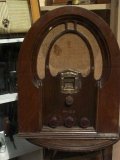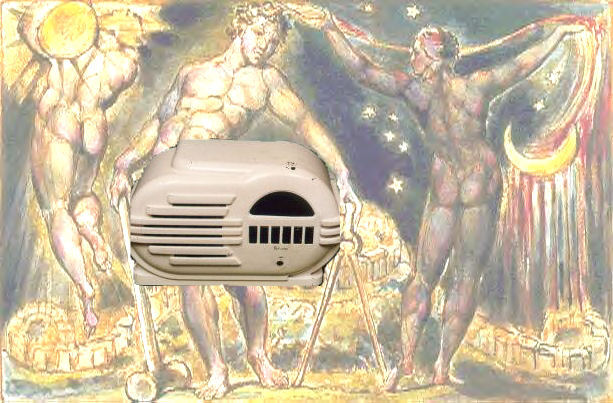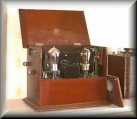The Revenge, a radio play without words, written and performed by Andrew Sachs in 1978
|
Shingler and Wieringa, 1998, 51 ff - Shingler,
Martin and Wieringa, Cindy, On Air. Methods and Meanings of Radio
(London: Arnold, 1998) From silence there emerges the sound of birdsong and then a faint humming noise which could be running water somewhere in the distance. A siren wails, shattering the tranquillity of this pastoral scene and a man's breathing is simultaneously heard in close-up, panting and pained. Footfalls are heard moving over soft ground, accompanied by the rustle of clothing and the panting of breath. In the distance, along with the birdsong, men's voices are heard shouting inarticulately, accompanied by dogs barking. Close-up, the man's breathing is laboured with intermittent gasps of pain. Each breath is forced out. It's the sound of fear. Feet running, distant voices shouting, dogs barking and, in the foreground, the continuing struggle for breath. The footfalls and the breathing become faster, more determined, even desperate. Then the sound of footfalls change, becoming softer. They rustle upon leaves. Branches snap under foot. They slow down and stop. The man catches his breath and sighs heavily. The shouts and barks seem all around. Running water can be heard more distinctly now. The footfalls resume and change their sound once again. They squelch. Then they splash, moving through water, first shallow but with each step becoming deeper and more laboured. The man grunts as he wades into the watery depths. The water surges, bubbles and plops. The man pants, filling his lungs with air. Suddenly he takes a deep breath. There is a subdued splash followed by a bubbling noise and at that moment all the other sounds become strangely muffled and distorted. The dogs and the men's voices are now heard through the water, gradually diminishing and leaving only the sound of the water itself. The water ripples around us (in stereo) until there is a brutal burst of sound, immediately followed by the man gasping for air. Panting and splashing follow. The sound of the men and their dogs are now far off. The breathing slows, becomes more rhythmic. Footfalls sound, squelching upon a soft carpet of leaves, hesitantly at first but gathering into a steady pace. There is no longer any sound of men's voices or dogs barking. The man sighs. A bird sings. The steady breathing and footfalls fade to silence. This is the first scene of The Revenge, a play without words,
written and performed by Andrew Sachs in 1978. This play, about
a man on the run (presumably having escaped from prison) who
eludes his pursuers, steals a motorbike, breaks into a house
in a remote rural location and there drowns another man in his
bathtub, was produced with sound effects alone: no words, no
music. It constructed its simple narrative through environmental
sounds (e.g., birdsong, water, gravel pathways, traffic noises),
through the sound of objects (e.g., doors, telephones, motorbike
engines, sirens, cigarette lighters, breaking glass, clock chimes,
ticking watches) and through bodily noises (e.g., sighs, panting,
breathing, grunting, the rustle of clothing, footfalls, exclamations,
humming, inarticulate shouting, meows). In so doing, the play
sought to exploit the dramatic possibilities of non-verbal sounds
(namely sound effects and acoustics) and prove that a story could
be told and, more particularly, could be understood without using
any recognisable words. Yet if it had not been called The Revenge,
and if the announcer had not proclaimed it to be The Revenge
before and after the play, would any of its listeners have had
any clue that these actions were motivated by vengeance? As it
stands, The Revenge demonstrates that audiences can recognise
certain actions solely through their sound: e.g., the man being
pursued across the countryside, his success in eluding the police,
steal- Jonathan Raban, writer of many radio plays produced by the BBC, has called The Revenge a 'wordless sequence of noises' and denounced it as 'a well-puffed curiosity' (Raban 1981: 80). He has criticised the play on the grounds that its assemblage of grunts, thuds, crunches, gratings and footfalls is ambiguous and confusing. For him, it stands for all that is wrong in contemporary radio drama. He sees it as the fruition of a trend in radio drama which has increasingly been putting sound effects before dialogue and attempting to evoke the sounds of the real world over and above an articulation of ideas (reality before art). Raban sees such a project as the product of producers and technicians rather than writers, whose primary objective is to create something along the lines of a sound cinema. Opposed to this, Raban claims, is another (older) tradition of radio drama in which writers approach the radio play as if it were an audible version of the printed page. Raban describes the major difference between these two approaches in terms of icon and symbol. The producer-technician creation he calls iconic, since it is concerned with sounding real and using real sounds, and the writer's creation he calls symbolic, given that it is concerned with conveying ideas through a set of conventional practices and codes of representation that substitute for reality (rather than replicate reality). He points out that for a long time radio was a writer's medium in which words ruled and sound effects performed an essentially supportive role, as little more than an embellishment. Moreover, the sound effects that were used were themselves symbolic rather than realistic, requiring the listener to interpret artifical noises (e.g., coconut shells for horses' hooves, drumbeats for heartbeats or footsteps). But, according to Raban, all that changed with the advancements in radio technology, most notably the introduction of VHF and stereo, which saw radio begin to 'manufacture its own iconic version of reality' (Raban, 1981: 83). In other words, radio began to replicate the world of everyday (or natural) sounds rather than create an intelligible (but artificial) representation of it. In the shift from symbolic to iconic representation, noises and sound effects assumed a greater role than words or music.
Beck, Alan, 1999, 'Is radio blind or invisible? A call for
a wider debate on listening-in', World Forum for Acoustic Ecology
(WFAE), electronic publication, 2.2 2.5 2.6 |
|
|




